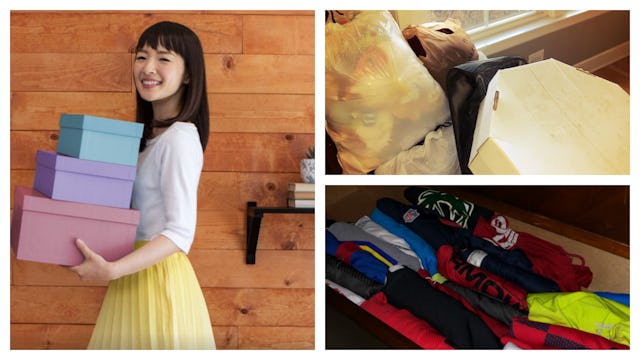I Tried The KonMari Method And Here's What Happened

Most days include some variation of “whose dirty socks are on the couch?” or “why are there nerf darts in the bathroom…again?” or “for the love of god, your clothes go in your drawers, not on the floor next to them.”
Such is the way with kids, I suppose. There’s a lot of stuff and it never seems to be in the right place.
It’s maddening. Absolutely maddening, I tell you.
But for some of us, the clutter and mess and constant influx of stuff is more than we can handle. I’m one of those people. Clutter and excessive stuff sends my anxiety into overdrive. I’m minimalist-ish – or as much as one can be when living with children, I suppose – which is why I was immediately fascinated by the new Netflix reality show Tidying Up with Marie Kondo.
I want to get better at tidying up, or should I say, I want my family to get better at tidying up.
In the interest of full disclosure, I didn’t read Marie Kondo’s book The Life-Changing Magic of Tidying Up when it came out a few years ago, mostly because the media hype soured me a bit. And there were so many articles written about the KonMari method that I felt like I already knew what it meant without actually reading the book. Thanks, but no thanks. I don’t need anyone else telling me that I need to get rid of stuff (I mean, don’t we already know this?). And the whole “get rid of it if is doesn’t spark joy” thing? Well, let’s be honest, I’d pretty much be setting my whole house ablaze if I followed that logic.
I was skeptical, to say the least.
And yet.
I’m always eager for new tips and tricks to own less and organize more – not to mention a sucker for a binge-worthy show – so first thing New Year’s Day, I opened Netflix and started streaming. And let me tell you within just a few minutes, I was hooked.
Like I said, I was skeptical about the whole “does it bring you joy” standard, but seeing sprite-like Marie demonstrate it with her little “ping!” squeal-and-smile made it all make sense. Yes, that.
I devoured the rest the entire season within a couple of days, and armed with some new tricks in my tool bag, I set out on converting my family to the KonMari method. As a someone whose minimalist-ish, my own clothes and belongings are fairly under control. I don’t have drawers busting open or purse and shoes spilling out of closets. My family is another story, however.
Christine Organ
But I was hopeful. And determined. So I told them the plan.
“We’re getting rid of shit, boys,” I said. “Let’s go.” (I’m nothing if not motivating, right?)
We first tackled their overflowing dresser drawers. And let me tell, the results were downright shocking. Not only were the kids on board with the new folding method, but they’ve even kept it up for a couple of days now. And they can actually see what they have so they no longer need to yell, “MOM, I DON’T HAVE ANY SOCKS!” while there are fifteen pairs of socks hiding under a mountain of old pajamas.
Christine Organ
Since my own wardrobe is already pretty bare-bones, I didn’t actually give away too much, but when I tried the fold-into-thirds clothing, it freed up so much space that I know have an entire drawer and a half that’s empty. I’m pretty sure I started feeling a contact high from the thrill of it.
Christine Organ
Jazzed at all the newfound space, I set out to tackle the basement, which was basically where random junk went to die.
Over the course of just a few hours, we filled several boxes and bags with stuff to throw away or give away. But even more than that, we created so much extra space for the things that we do have. The things that actually bring us joy and serve a purpose.
Christine Organ
And I think that’s the real magic of KonMari. She doesn’t tell you that you need to toss out the entire contents of your home or get by with only 33 articles of clothing. In fact, most of the people on the show ended with far more “stuff” than would make me comfortable. I had legit anxiety when I saw the amount of clutter and stuff some people had – even at the end of it all – but it was so much better, and they were thrilled with the results without feeling deprived in a way that so many other “minimalist” or “less is more” strategies can make you feel.
Because it’s about what makes you comfortable. And that’s the real joy of it all.
This article was originally published on